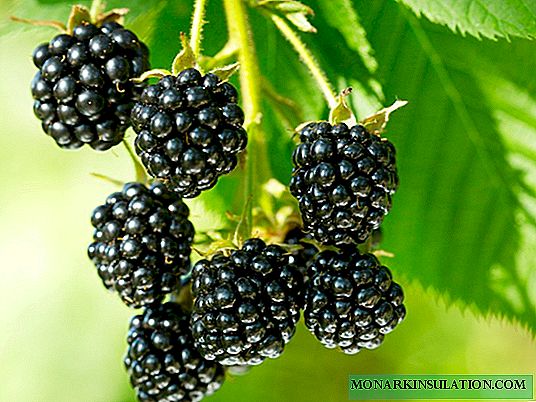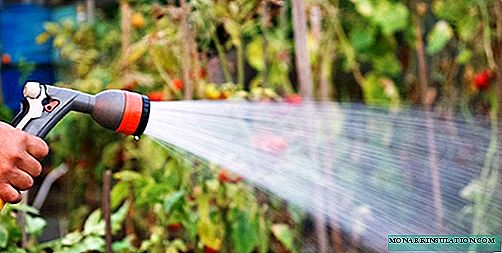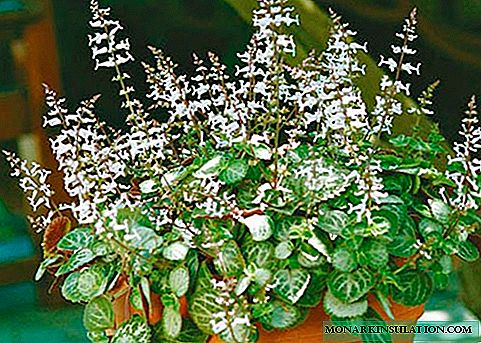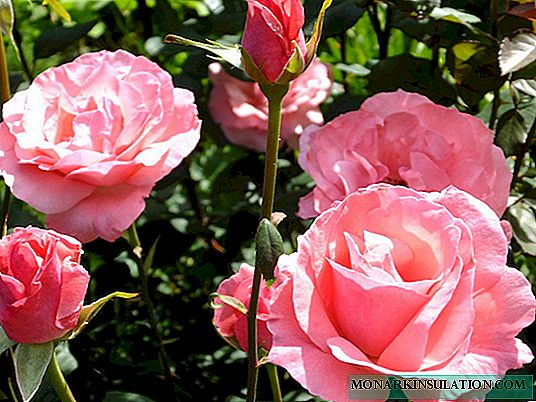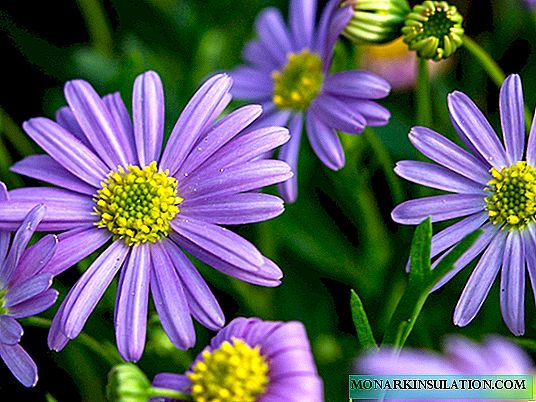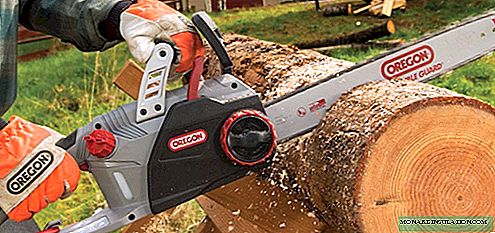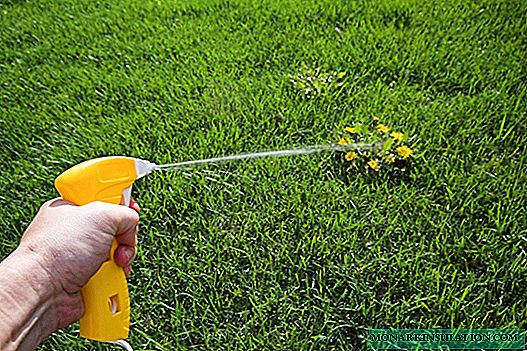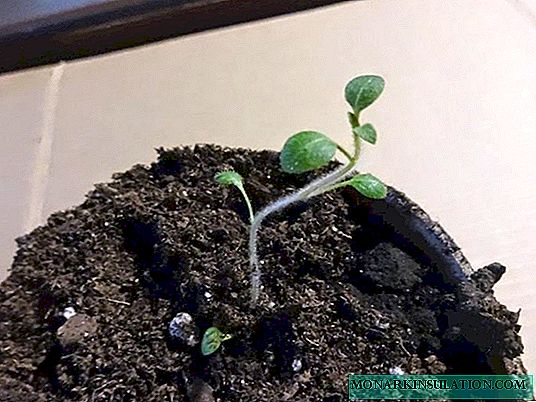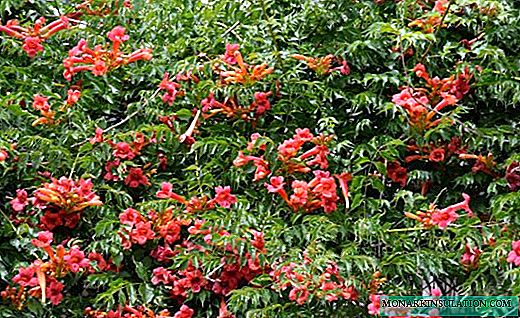Campsis is a beautiful fast-growing vine of the Bignonius family. Homeland plants are North America and China. In Europe, it has been actively used to decorate gardens since the 17th century. At walls or fences, the campsis forms dense thickets with sprawling shoots, which are covered with large and bright colors. Liana perfectly survives in the open ground of the southern regions and central Russia. Popularly, it is also known as tekoma. Having mastered the simple rules of care, any gardener can easily achieve flowering and pacify the growth of a lush beauty.

Botanical Description
Campsis is a fast-growing, deciduous perennial with a developed rhizome. The roots spread not only inland, but also occupy a vast territory. Young growth can appear at a distance of several meters from the main thickets.
Young shoots have a smooth green bark. As they age, they become lignified and acquire a red-brown color. In the internodes there are aerial roots and a pair of opposite leaves on long petioles. Each petiole carries 7-11 oval or ovate leaf plates. Toothed edges are distinguishable on the leaves. The front surface is glossy, and the reverse has a slight pubescence along the main veins.











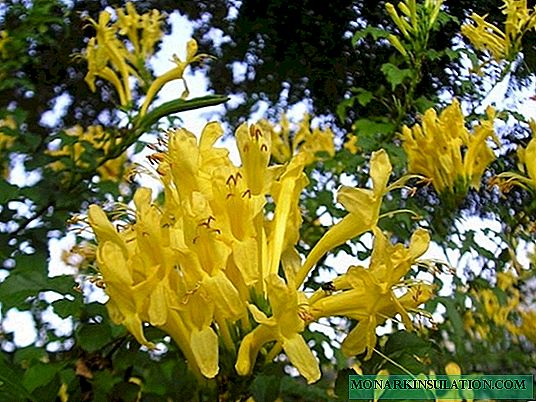
Numerous inflorescences bloom on shoots throughout the summer. Each peduncle carries 2-8 tubular flowers with a diameter of up to 8 cm. The corolla consists of five petals fused at the base with bent edges. They are painted in pink, orange, raspberry or golden color.
After pollination on vines, hard pods 8-10 cm long ripen. Small, pubescent seeds of a dark brown color hide in a bivalve pod. A fully ripened fruit opens independently and the wind easily spreads seeds over long distances.
Types and varieties of campsis
The few genus of campsis includes only 3 main species and several decorative varieties.
The most common is campsis rooted. Liana with long (7-9 m) shoots can develop powerful roots in internodes and cling to any surfaces. Each petiole contains 9-11 leaf blades with rare pubescence on the reverse side. Tubular flowers reach a length of 6 cm. They are collected in carpal inflorescences at the tops of shoots. A bright orange tube turns into a red limb at the ends of the petals. The plant prefers a warm climate, but is able to withstand short-term frosts down to -20 ° C.

Popular varieties:
- Flamenco - vines up to 5 m long in July-October are covered with bright red inflorescences;
- Flava - light yellow buds bloom on the vine in July-September;
- Early - blooms in early June with large flowers of a rich red hue.
Campsis is large-flowered (Chinese). A flexible liana without aerial roots encircles the support with young processes. On petioles 7-9 cirrus leaves about 6 cm long are located. The pubescence on this variety is completely absent. Flowers with a narrow tube in length are about 8 cm. They are painted in fiery orange. Shoots are more modest in size and often take the form of a spreading bush. The plant prefers a warm content, but can tolerate short-term frosts down to -18 ° C.

Campsis is hybrid. A relatively young variety with large flowers and flexible vines 4-6 m long. It is characterized by good frost resistance and high decorativeness. The popular variety "Madame Galen" is a sprawling bush with red-orange large flowers.

Breeding methods
Campsis propagation can be carried out by seed and vegetative methods. Seeds are pre-sown on seedlings. They do not need additional processing or stratification. It is enough at the beginning of March to distribute the seed in boxes with loose, fertile soil at a depth of 5 mm. The pot is kept at a temperature of + 25 ° C and periodically moisten the earth. Shoots appear in 20-25 days. When 5-6 true leaves grow on a young vine, it can be transplanted to a permanent place. The disadvantage of this method of propagation is that the seedlings bloom only for 7-8 years after planting, and varietal qualities are poorly inherited.
Vegetative propagation allows you to quickly get a lush flowering vine with the signs of a mother plant. For him, the following parts of creeper are used:
- Cuttings. In the first half of summer, medium shoots without buds are cut. It is necessary to take a segment with 2-3 leaves, the leaf plate is cut to 2/3. Rooted seedlings in sandy peat soil at an angle of 45 °. The soil near the plant is mulched and periodically watered. Viable roots appear within a month in 90% of the cuttings.
- Root growth. Root processes often appear around the bush. Even faster, they form when the rhizome is damaged, so after digging up the earth near the campsis, many shoots are formed. They already have independent roots. It is enough to carefully dig out the plant in early spring or late autumn and transplant to a new place.
- Layering. In April-May, it is necessary to crush the semi-lignified shoot of the campsis to the ground. All season, the soil near it is loosened and watered. By next spring, layers will have an independent rhizome. It is separated, the slice is treated with crushed charcoal and transplanted to a permanent place.
Care Rules
Campsis is characterized by high survivability and unpretentiousness. It, like a weed, grows very actively and gives offspring. However, in order to achieve abundant flowering, a number of care rules must be observed.

Lighting. For active growth and bud formation, the campsis needs a lot of light. Better to choose open areas for it. Even in intense heat, direct sunlight will not cause burns.
Temperature. The liana feels best in the warm southern regions. In the middle lane, shoots do not grow so actively, and in the winter they will require shelter. It is advisable to choose a place protected from drafts for planting.
Wintering. The roots of the campsis are covered with lapnik, fallen leaves and sawdust. If the vines can be removed from the support and pressed to the ground, they are covered with the same material as the roots. Liana on supports is wrapped with lutrasil and polyethylene.
Watering. On hot days and during flowering, kampsis needs abundant watering, but can withstand a little drought. It is important to prevent regular stagnation of water in the soil.
Top dressing. On fertile soil, a liana can grow without fertilizer at all. With a lack of nutrients, it is recommended to use nitrogen-phosphorus complexes. They will make flowering more plentiful and long.
Pruning. Regular pruning is essential for the campsis throughout the year. At the beginning of spring, part of the old or frozen shoots should be cut to stimulate the growth of young branches. It is on them that dense inflorescences blossom. As the buds fade, you can remove them and pods. In the fall, radical pruning should be carried out so that the liana does not go beyond the allotted territory.
Possible difficulties
Campsis practically does not suffer from diseases. Only with frequent flooding of the soil can it be affected by root rot. Since the rhizome quickly sprouts, it is enough to change the irrigation conditions and remove the affected areas.
Of all the parasites, only aphids periodically attack flowers and young leaves of creepers. Treatment with insecticides will help get rid of it. It is worth spraying the plant in early summer for prevention.
If the campsis does not bloom, this may be due to the attack of parasites, too cold winters or poor soils. Young plants from cuttings bloom in the third year, and seedlings - not earlier than 7-8 years.
Campsite Use
This beautiful, fast-growing liana will fill the garden with bright colors and marvelous aromas. It is perfect for decorating fences, arches or arbors. It should be planted near farm buildings in order to hide ugly walls under green vines.
Campsis flowers can be used to make bouquet compositions. They will stand in a vase for 1-2 weeks and will delight you with bright colors.
It is important to remember that the aerial roots of the campsis rooting are very strong. Rising along the wall of the house, they are able to grow into the thickness of the foundation and bricks. Also, fragrant flowers attract a lot of insects that can fly into the room through open windows. For this reason, it is best to plant a campsis at some distance from home.

